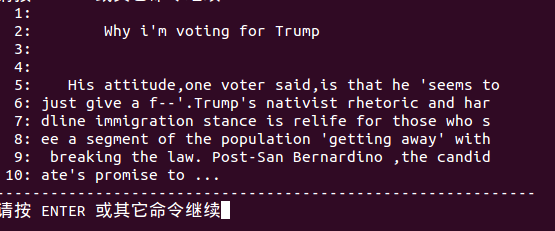今天写一下串这个结构
串是字符串的简称,是一种特殊的线性表,是处理非数值计算问题的主要对象。串也是非常有用的,我们非常熟悉和非常有名的编辑器VIM也主要是在倒腾串。
串也有多种存储结构,包括:顺序存储结构,堆存储结构,和链式存储结构。
顺序存储结构的实现就比较简单了,就是一个定义一个大小固定的字符数组,当然它的劣势也是很明显的,因为串的大小是非常不固定的,所以事先定义
一个很大的数组的话无非会导致一些内存空间的利用率非常底下,浪费严重。
堆结构就是随时分配空间,用完再释放掉,基本不会造成浪费,是我最喜欢的结构。主要用到malloc()函数和realloc()函数。
链式存储结构就是一个字符类型的链表,咋说呢,不好也不坏,还行吧。
今天我写一个堆结构的串。
先来总结一下串应该有的操作:
1.初始化串
2.求串长
3.取子串
4.格式化遍历(打印)串
5.定位串(查找某一子串是否存在)
6.串了连接
7.串比较
8.判串空(我们不单独实现它,而是通过求串长来实现)
9.串替换
10.串赋值
11.串插入
12.串删除
大家也能看出来,串是可以整出很多花招的
我只实现串的部分操作
定义串结构
/* define a string */
const int LINELENGTH = 50;
struct string{ int length; char *ch; };
1.初始化串
/* init_string */ int init_string( struct string *s,char *str ) { char *temp_str = str; s->ch = malloc( sizeof(char) ); s->length = 0; while( *temp_str != '�'){ if( !(s->ch = realloc( s->ch,sizeof(char) + s->length )) ){ printf("failure : error of memory allocation. "); return 0; } s->ch[s->length] = *temp_str ++; s->length ++; } s->ch[s->length] = '�'; return 1; }
2.求串长
/* getting string length */ int get_str_len(struct string *s) { return s->length; }
4.格式化遍历(打印)串
/* print string */ int print_ch( struct string *s) { char *p = s->ch; int cnt = 0; while( *p != '�' ){ if( *p == ' ' ){ cnt = cnt + ( LINELENGTH - cnt%LINELENGTH); p ++; } if( cnt % LINELENGTH == 0 ){ if( cnt != 0 ){ printf(" %3d: ",cnt/LINELENGTH + 1); }else{ printf("%3d: ",1); } }; cnt ++; if( *p != ' ' ){ printf("%c",*p ++); } } putchar(' '); for( cnt=0;cnt<LINELENGTH+10;cnt++ ){ putchar('-'); } return 1; }
我这个打打印串的函数是按照一定格式输出的,带有行号输出
我从cnn上面摘抄了一段支持普朗特的新闻测试了一下

其它的功能今天没时间写了。。。